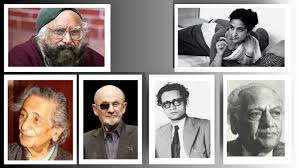The independence of 1947 did not arrive alone it carried with it the shadow of Partition. As India and Pakistan emerged, millions of people were forced to leave behind homes, livelihoods, and familiar streets. Violence erupted, and the wounds it left behind cut deep into the psyche of the subcontinent.
While history books recount dates and decisions, literature remembers feelings. Through fiction, poetry, and memoir, these six writers brought to life the human stories hidden beneath political events.
1. Amrita Pritam – Punjab’s Cry for its Lost Daughters
In her unforgettable poem Ajj Aakhaan Waris Shah Nu, Amrita Pritam calls upon the 18th-century Punjabi poet to awaken and witness the tragedies of her homeland. Her verses mourn the women abducted, the families shattered, and the rivers of Punjab running red. For countless readers, Pritam gave poetic form to a grief too large for prose.
2. Faiz Ahmad Faiz – The Dawn That Disappointed
Faiz’s Subh-e-Azadi reflects the bittersweet truth of independence. Freedom arrived, but it was shadowed by loss. The poem’s imagery is that of a morning clouded over, promising light yet delivering sorrow—a sentiment that captured the mood of many in 1947.
3. Salman Rushdie – A Nation’s Birth Through Magical Eyes
In Midnight’s Children, Salman Rushdie tells the story of Saleem Sinai, born at the exact moment of independence. By mixing magic realism with political history, Rushdie shows how the chaos of Partition reshaped the lives of the powerless more than the fates of leaders. His narrative reminds us that grand events are often most brutal for the ordinary.
4. Bhisham Sahni – Old Fault Lines Resurfacing
Bhisham Sahni drew a chilling connection between the riots of the 1970s in Bhiwandi and the carnage of 1947 Rawalpindi. His novel Tamas became a landmark in Partition literature, illustrating that the prejudices and mistrust of that era never fully vanished.
5. Khushwant Singh – A Village on the Brink
Train to Pakistan transports readers to Mano Majra, a sleepy village suddenly thrown into the storm of Partition. Khushwant Singh’s unflinching storytelling lays bare the way violence can creep into even the most peaceful of places, tearing apart bonds that once seemed unbreakable.
6. Saadat Hasan Manto – A Border Inside the Mind
Manto, who moved from Bombay to Lahore after Partition, wrote of a mental border that could not be drawn as easily as the physical one. His stories, such as Toba Tek Singh, revealed the absurdity and cruelty of dividing a shared history into two separate identities.
Why These Voices Still Matter
Each of these writers gave us more than accounts of Partition they gave us emotional truth. Their works ensure that the pain, resilience, and complexity of 1947 are not forgotten. By revisiting them, we remember that independence was not only a celebration, but also a moment of irreversible loss.


